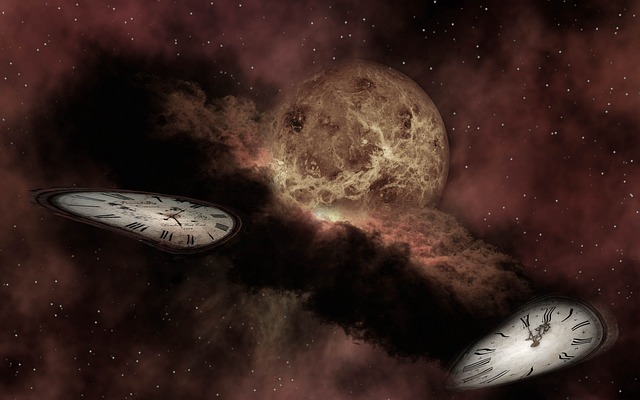Time dilation is a fascinating aspect of physics that highlights the relationship between time and motion. It was first predicted by Albert Einstein’s theory of special relativity, which states that the laws of physics are the same for all observers in uniform motion relative to one another. One of the key consequences of this theory is that time appears to pass differently for objects moving at different speeds.
Time dilation occurs because of the difference in velocity between two objects. According to special relativity, the faster an object moves, the slower time appears to pass for that object. This is known as “relativistic time dilation” and it is a direct result of the theory of special relativity.
In addition to time dilation caused by motion, there is also time dilation caused by gravity. According to Einstein’s theory of general relativity, time passes more slowly in a stronger gravitational field. This is because the presence of a massive object, such as a planet or a star, distorts the fabric of spacetime, causing time to flow more slowly.
Time dilation has been confirmed by numerous experiments, we will explain a few experiments in a bit more detail.
Classic example of time dilation – “Twin paradox”
“Twin Paradox”. In this thought experiment, two twins are separated, with one twin remaining on Earth while the other travels away in a spaceship at high speeds and then returns. Upon their reunion, the traveling twin will have aged less than the twin who remained on Earth.
This apparent difference in aging is due to time dilation, which occurs because of the difference in velocity between the two twins. According to Einstein’s theory of special relativity, time appears to pass more slowly for an object moving at high speeds. So, for the twin traveling in the spaceship, time passed more slowly due to his high speed, resulting in less aging compared to his stay-at-home twin.
The Twin Paradox is a classic example of time dilation because it demonstrates the real-world effects of the phenomenon in a simple and understandable way. It highlights the fact that time is not an absolute constant, but rather, it depends on the relative motion and position of the observer.
Time dilation experiments, which proven that time dilation does exist.
- The Pound-Rebka experiment: This experiment involved emitting gamma rays from the bottom of a tower and detecting them at the top. The results showed that the gamma rays were red-shifted, indicating that time had passed more slowly at the bottom of the tower due to the stronger gravitational field.
- The Hafele-Keating experiment: In this experiment, four atomic clocks were flown around the world in airplanes traveling east and west. When the clocks were compared with clocks that remained stationary on the ground, the results confirmed time dilation due to motion.
- The GPS system: The Global Positioning System (GPS) relies on time dilation in order to function correctly. GPS satellites are moving at high speeds, so their onboard clocks run slower compared to clocks on the ground. This difference in time is factored into the GPS calculations, ensuring accurate positioning information.
Time dilation in space and other planets.
Time dilation also occurs in space and on other planets due to the differences in their gravitational fields. According to Einstein’s theory of general relativity, time passes more slowly in stronger gravitational fields. This means that time will appear to pass more slowly on a planet with a stronger gravitational pull compared to a planet with a weaker gravitational pull.
For example, time passes more slowly on the surface of the Earth compared to in space, due to the Earth’s stronger gravitational field. Similarly, time would pass more slowly on a planet with a stronger gravitational field compared to the Earth, resulting in greater time dilation.
This phenomenon can have significant consequences for space travel and exploration. For example, if astronauts spend a long time on a planet with a strong gravitational field, they will experience less aging compared to people on Earth, and they will also experience less time dilation compared to their spacecraft, which is moving at high speeds through space.
Time dilation near a black hole is one of the most extreme examples of the phenomenon. According to Einstein’s theory of general relativity, time passes more slowly in stronger gravitational fields. Black holes have extremely strong gravitational fields, so time dilation is most pronounced near them.
As an object approaches a black hole, its gravitational pull becomes stronger, causing time to pass more slowly. At the event horizon, the point of no return for objects falling into a black hole, time appears to come to a complete stop from the perspective of an outside observer.
For an object that crosses the event horizon and falls into the black hole, time will appear to pass normally, but it will still be passing more slowly compared to an object that is far from the black hole. As the object approaches the singularity, the point at the center of the black hole where the laws of physics break down, time dilation becomes infinite, meaning that time appears to stop completely.

Time dilation is related to time traveling?
Time dilation and time travel are related concepts in the sense that time dilation can be used to explain certain aspects of time travel in the context of theoretical models.
According to Einstein’s theory of general relativity, time dilation occurs as a result of differences in the strength of gravitational fields. If a person were to travel at high speeds through a region of space with a weaker gravitational field, they would experience time passing more slowly relative to someone who remained in a region of stronger gravity.
In the context of time travel, this means that a person who travels into the future in a region of weaker gravity would experience a slower passage of time than someone who remains in the present. This opens up the possibility of time travel into the future, in a manner similar to the concept of time dilation in “Interstellar”.
It is important to note that time travel remains a largely theoretical concept, and there is currently no experimental evidence to support the idea that it is possible. Additionally, there are many scientific and technical challenges that must be overcome in order to develop a practical means of time travel.
Is Time Dilation In Interstellar Accurate?
In the movie “Interstellar”, time dilation plays a central role in the plot. The movie depicts a future where Earth is facing a catastrophic crisis, and a team of astronauts embarks on a journey through a wormhole in search of a new home for humanity.
The portrayal of time dilation in “Interstellar” is largely accurate from a scientific perspective. The film accurately depicts the fact that time passes more slowly in stronger gravitational fields, and that this can result in significant differences in the aging of objects in different gravitational environments.
However, like most Hollywood productions, the film takes some liberties with science for the sake of dramatic effect. For example, the time dilation experienced by the astronauts in the movie is much greater than what would be expected in reality, given the strength of the gravitational fields depicted. Additionally, the way the wormhole and black hole are depicted in the film may not be entirely accurate according to current scientific understanding.

Does Time dilation happen during flying in an airplane? Can we see the time dilation?
Time dilation during flying in an airplane is a subtle effect that occurs as a result of the relative velocity of the airplane with respect to the Earth. According to Einstein’s theory of special relativity, time passes more slowly for objects that are moving at high speeds relative to an observer.
In the case of an airplane, the relative velocity between the airplane and the Earth is not great enough to cause a noticeable difference in the passage of time. The effect is very small, and would only be noticeable over very long time periods. For example, an airplane flying at speeds of hundreds of miles per hour for a period of several years would experience only a few milliseconds of time dilation.
It is important to note that time dilation due to relative velocity is a different phenomenon from time dilation due to a difference in gravitational potential. For example, time passes more slowly at higher elevations, where the gravitational potential is weaker. However, this effect is also very small and is not typically noticeable over the short time periods involved in typical air travel.
Why does time dilation works?
Time dilation works because of the theory of special relativity, which was developed by Albert Einstein in 1905. Special relativity states that the laws of physics are the same for all observers moving at a constant velocity relative to one another. This means that the laws of physics will appear the same to someone on a moving train as they do to someone standing still on the platform.
One of the key predictions of special relativity is that the passage of time is relative to the observer. This means that time will appear to pass more slowly for an observer in a system that is moving at a high velocity relative to another observer. This effect is known as time dilation.
The reason time dilation works is because of the relationship between space and time in special relativity. According to special relativity, space and time are not separate entities, but are instead combined into a single four-dimensional space-time. The faster an object moves through space-time, the more time is “squeezed” in the direction of motion. As a result, the object’s clock will appear to tick more slowly.
Additionally, the theory of general relativity, which describes gravity, also predicts time dilation. The stronger the gravitational field, the slower time passes. This effect is known as gravitational time dilation.
Finally…
Lets conclude time dilation is an interesting and mind-bending aspect of physics. It shows that time is not an absolute constant but depends on the observer’s relative motion and position. It’s a reminder that our understanding of the universe is constantly expanding and that there is much we have yet to discover.
